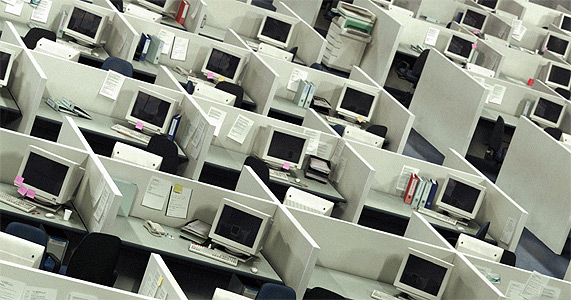
In the previous blog we looked at how businesses are toying with the idea of having a ‘roaming’ workforce but ultimately employees need the cultural side of an ‘office’ environment to thrive. In this blog we will look at what factors will force the traditional workplace to adapt, and how it is likely to change, if at all. We still need an office in our lives, we love the ‘banter’, love the unity it brings. But what form will it take?
Setting the trend for workspace innovation for the last twenty years has been the West Coast tech companies, with their slides, touch screen everything and lots of very bright objects all over the place. When the term ‘office of the future’ is thrown around everybody looks to straight to ‘Silicon Valley’ innovators. But, is this the office of the future, or just extravagant and hedonistic interior design? These flashy offices look great, but working around a £450,000 art installation said to increase creativity and productivity by 20% isn’t really a viable option for the average business, especially businesses that aren’t driven by creativity. But what can regular Joe SME’s take from their lead? Bauhaus inspired ergonomic flexi chairs aside.
The workplace of the future has to be technology driven and design driven but above all else it has to be people driven. One trend coming out of the workspace Avant-Garde is a move towards communal workspaces. ‘canteen style’ workstations where everybody sits around large tables. In most workplaces allocated desks anchor people spatially to the spot. Wandering away from the desk is seen as procrastinating and avoiding work. This can prevent collaboration between employees in large offices.

Microsoft’s offices in Amsterdam, a canteen style communal workplace
In one of Microsoft’s new facilities based in Amsterdam the staff no longer have a desk to themselves. They are encouraged to decide where they work when they arrive in the morning, and the nature of work they have to tackle that day dictates the seating arrangements. The idea that the office should be split up in to different ‘task’ rooms is an interesting one. A room for creative tasks, a room for new business development, a separate room for admin and email correspondence etc. This would surely improve productivity as everybody is on the same task, motivating each other and hubs of activity can be created around the workplace. As well as these benefits, providing open workspaces and desk sharing can improve office space utilisation by up to 77% a channelinsider.com report has shown.
So the ‘Desk’ is dead and the seating plan has been thrown out the window. But is that what employees want? And after all the workplace of the future should be ‘people’ driven. In our office of about 30, we all sit at allocated workstations, I’m sure like most offices of that size. About every six months we have a desk re-shuffle, and it is a painful process. Nobody ever wants to move as they have lost their space by the window, or they are too close to the door, or they have have lost their ‘good chair’, or ‘good screen’, or are no longer sitting next to the printer/biscuit tin/their office crush. This shows how people grow attached to the space around them, they take ownership of it and see it as ‘their desk’. This doesn’t sit well with the idea of having communal workspaces. The ‘form’ of the office that we spoke of in the previous blog (that hasn’t really changed since the fifties) maybe it hasn’t really changed because people have grown accustomed to it, and are attached to it. They want their desk, and failing that they want something that looks very similar, or they can’t settle into a regular pattern of productivity.
You can walk into any Staples store and buy day vouchers for office space, whether that’s a single hot desk, or a whole office floor. The workspaces are globally available, and there are 52 different offices in London alone. It seems that even when people are travelling away on business, they actively seek out the familiarity of an office space to get work done, where a hotel desk and hotel Wi-Fi would surely do the job. The traditional office form of desks and allotted space is ingrained into us; we have inherited it from our predecessors, seen it in films and read about it in books. It is a part of our culture and and we associate it with getting things done. Picture the main guy from that popular film pulling a late one at the office, he’s not perched on a stool with a laptop in his communal canteen style workspace, he is sat behind a desk, his desk.
Like the other blog, we seem to just be creating problems not solutions, in piecing together the workplace of the future. The traditional workplace is going to be a hard one to shrug, even if it doesn’t always make spatial, cultural and commercial sense. We haven’t even covered the technology side of things yet, the lasers, holograms and robots that we’re all hoping will be involved in some mythical capacity. In the next blog we will, finally, be focusing on how technology will dictate change in the way workplaces will function, again tackling the inevitable backlash from trying to meddle with the traditional form of the ‘office’.
In the mean time have a look at this Microsoft concept video of what it will be like 2019. A bizarre world where Apple, Ikea, and paper manufacturers have disappeared, everything looks impossibly complicated to navigate, and Microsoft seem to have monopolized everything from magic plane tickets to magic mugs to magic newspapers.
What’s your view – Is the ‘traditional’ office a dying breed or is it here to stay. How should it adapt? Are employees holding back progress for the sake of familiarity? So many questions. What do you think?

